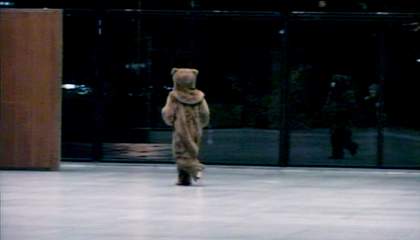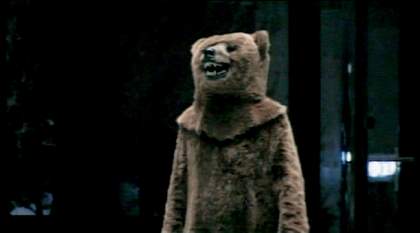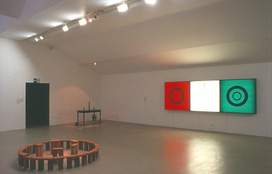Cast your mind back, if you can, to the autumn of 2003, when the magician David Blaine starved himself for 44 days inside a Plexiglas box hanging above the Thames. Though I remember it cringingly now as a short-lived trend I plodded alongside, I went every day for nearly a week and stood underneath his glass box. There was something about his slumped, sequestered figure that I convinced myself connected us – two Americans living in London, feeling ridiculed and isolated and alone. When he waved down to the crowd gathered below him, I was sure he was waving directly at me.
Not long after, when Mark Wallinger told me he would be spending nine nights alone in the iconic Neue Nationalgalerie in Berlin (a building that was designed to look as much like a glass box as any building can) dressed as the city’s mascot (a bear), I immediately imagined hecklers pelting the glass with kebabs and currywurst. But unlike Blaine, who assumed his magic act of martyrdom would translate easily across the Atlantic, Mark’s test of endurance was playful enough to turn a potential target of ridicule into a site of sympathy.
The Neue Nationalgalerie is located near the overdeveloped but eerily empty Potsdamer Platz, and the museum itself feels oddly isolated, especially at night. The structure is inherently contradictory to displaying art: there are no walls, only towering glass windows supported by steel girders. But it is an ideal container for a single artwork – a twinkling hollow jewel case for whatever’s inside. Approaching the austere yet warmly lit building late on a Wednesday night, I found no over-spilling raucous crowd such as the one drawn to Blaine, but an intimate clutch of people dressed in puffy winter coats, standing respectfully away from the glass. They peered curiously inside, snapping pictures and holding children up to the window. The museum’s most recent exhibition had already moved on, and the marble floors were bare. The only thing inhabiting Mies van der Rohe’s Modernist landmark was Mark.
But it wasn’t Mark. Nor was it really a bear. He shuffled and paced around on two feet, balancing his unwieldy bear head, looking generally like a man in a rented bear suit. I had pictured a shabby costume similar to those worn by people hired to hand out promotional flyers or entertain at children’s parties, and, indeed, the lower part was made of a fuzzy kind of fur that resembled a matted old blanket, which hung off his limbs like baggy flesh. But the head was far more realistic than the rest. It wasn’t the comical headpiece of a Disney character, nor were its eye sockets made of cheap mesh through which you could glimpse the artist’s face. This rested awkwardly on his shoulders, as if he had just placed his own head into the kind of taxidermied trophy you find mounted on the wall of a hunting lodge. The bear’s expression was still frozen in a stiff roar that was menacing from the front, but in profile looked like he might be grinning, or even laughing.

Mark Wallinger
Sleeper at the Neue Nationalgalerie, Berlin, 2004–5
DVD
Still image
© Mark Wallinger
As I stood watching him in his illuminated vitrine, and he, in turn, watched us, I couldn’t detect Mark anywhere inside the animal. I was sure he would make some sort of gesture of recognition towards us, but he only stood there, his suit dangling from his limbs, his bear head bobbling slightly. I worried the mask was suffocating him, or that he had gone into some trance. I felt a strange sensation – not of disconnection, but of real sympathy. Mark embodied the confused animal kept in captivity, the misunderstood and befuddled beast, trotting around the empty space, inspecting the walls and windows and floors like a visitor lost in a hotel lobby or a vacant bank. He could easily have made a mascot out of himself, acting for the crowd’s entertainment, but there was something forlorn and introverted about this performance – to see him pulling his knees up to his chest beside a heating vent, or lying on the floor with exhaustion. Like Blaine, the artist was elementally, almost primitively alone. But while Blaine’s stunt turned itself into a spectacle, Mark’s self-imposed hibernation turned inward, to create a character I could pity – like a ghost who can’t communicate with the people he’s trying to haunt. But it was a comic character, too. At times it seemed as if he were living out a childhood dream of prowling a museum after hours, at his own pajama party with priceless works of art.
A few days later I watched Sleeper on a live video feed at the German Embassy in London, during a crowded cocktail party in which the bear, trapped both in the museum and in the monitor, seemed irrevocably far away. It was easy to turn my back on the constant surveillance, and I felt a bit guilty eating German meatballs while the guest of honour was alone in his cage. Occasionally I glimpsed him between bites of sausage, only to see him slumped in a corner, or running chaotically around. The artist seemed to be searching restlessly for a place within the museum where he could be comfortable, where he could belong, but ultimately the building refused him. Visitors, too, were kept outside in the cold, able only to cup their hands against the glass to see the exhibition.
The most remarkable aspect of Mark as a bear was the way he managed to bring the museum itself to bear on his performance. He brought out the building’s nature – its essence as a giant vitrine. At times he ran wildly from one corner to the other, or hid between the two wooden walls, or lay splayed on the floor. But when he disappeared behind one of its columns, or got lost in the reflections in the glass, he left something behind – the building was still animated, even alive. Despite the museum’s immense proportions, manufactured materials and cold exterior, all it needed was this one living thing to make it breathe.



